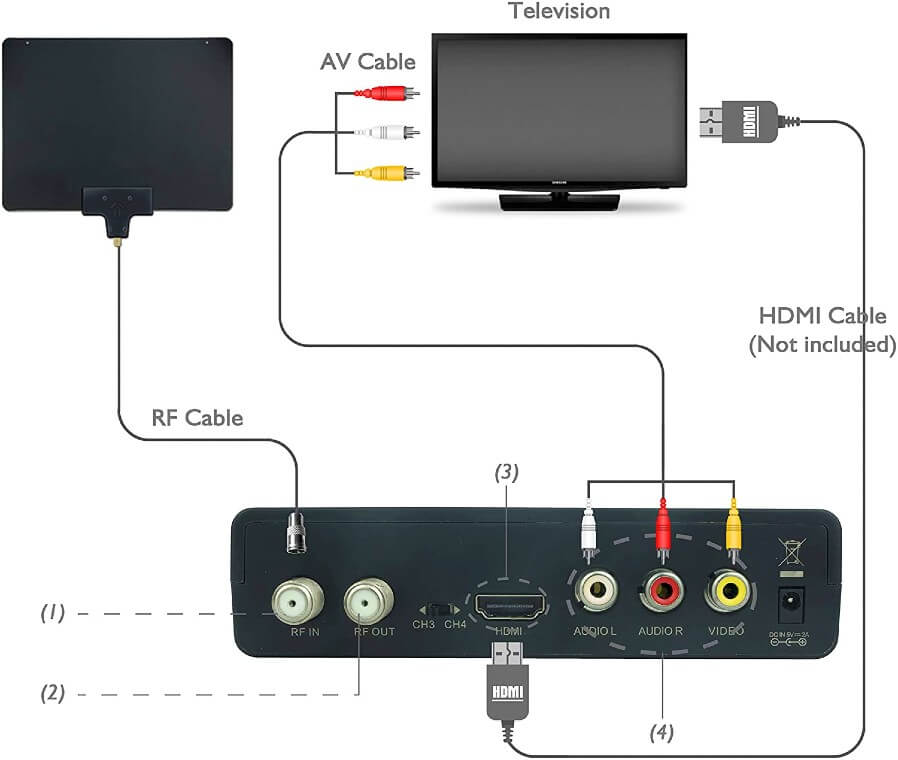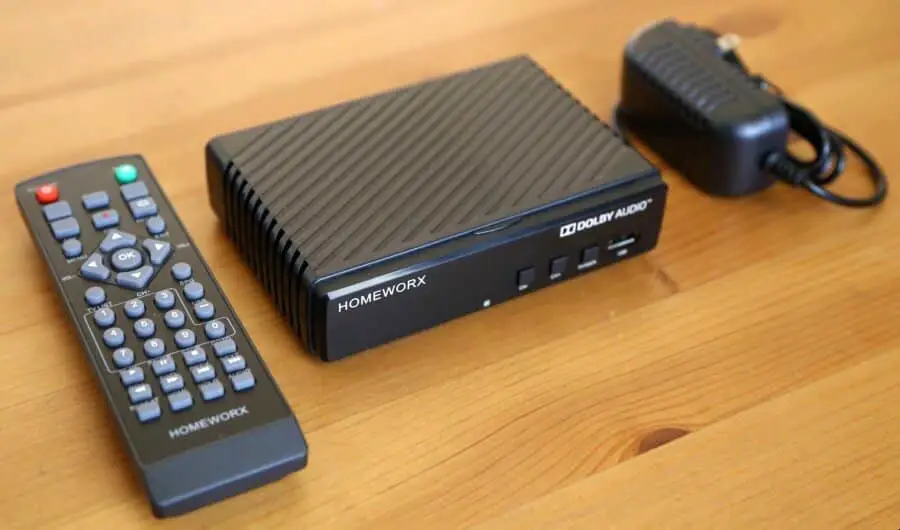Projectors, TVs, and PCs with their own bunny-ear antennae employ the TV tuner with coaxial connection to receive terrestrial or broadcast (free) TV station signals. In the case of televisions, they’re mostly employed to improve signal or reception.
Because it can’t replicate the TV antenna connection of a Cathode-Ray Tube (CRT) TV, the TV tuner is the only means for projectors to receive TV signals. Mirroring is possible with HDTVs, but only if both the projector and the HDTV are smart devices.
Best TV Tuner for Projector Review
Mediasonic ATSC Digital Converter Box comes highly recommended. To cut a long tale short, the MediaSonic HW130STB’s features are still there and ripe for experimentation, despite the fact that its barebones instruction booklet does a poor job of explaining them.
We discovered picture or screen settings, channel search, recording functions, recording playback, and easy setup on a device that connects to any HDTV, PC, or projector with an HDMI port (and what device doesn’t have an HDMI port at this moment in time?).


- Receive Over-The-Air Digital Broadcast to your Analog and Digital TV, Projector, and Computer Monitor. Antenna Out Analog Pass Through, Favorite Channel List, Parental Control Function
- HDMI 1080P Output / Composite Out / Coaxial Output, Closed Caption, Auto Tuning, Timing Start Up & Shut Down.
- Real-Time Recording & Programmed Time Recording, recording require user to connect a USB 2.0 or 3.0 2.5" / 3.5" External Hard Drive via USB (Up to 2TB, MBR format) (USB Flash Drive Not recommended)
- USB Multimedia function play back Video, Music, Photo from USB Drive
- PLEASE NOTE**:This converter box is designed to receive Over-The-Air signal, and it is not a replacement of cable box. External Antenna is required to connect to this converter box in order to receive signal. This product does NOT Work with TIVO and cable company such as Comcast, DirecTV, DISH Network, Time Warner Cable, etc. In general, this product does NOT work with encrypted cable signal
Here are The Reasons Why in Tabulated Form:
| Advantage | Disadvantage |
| It supports at least 32 GB of memory of USB flash drives. By hitting the Menu button and selecting Channel Search, you can search channels automatically. l By pressing the EPG button and selecting a channel, you can record footage to your flash drive. l You can choose between recording immediately, once, daily, or weekly. l It’s relatively simple to set up. Simply connect the tuner to the coaxial line and the TV to the HDMI cable (not provided). | The manual isn’t really useful. According to a minority of users, some units have poor video quality. |
What to Look for in TV Tuners 101
In terms of projectors, the fundamental attractiveness of TV tuners is that they function similarly to the bunny-ear TV antennas found on older televisions or the more complex digital antennas found on modern televisions. Sure, in the 2020s, TVs have ditched antennae in favor of cable or satellite box connections.
When looking for TV tuners, though, you’ll see options like NTSC, SECAM, clear QAM/ATSC, and so on. Options and FM radio are even available in some cases. They’re set up such that a coaxial cable may link them to an antenna.
Differences Between NTSC and PAL (and SECAM)
The European Union or Western Europe (the United Kingdom, Germany, and Australia) and Asia (except for Japan and the Philippines) all utilize the Phase Alternating Line (PAL) color encoding method.
PAL was created in Germany and was first used by Western Europe. In 1967, the United Kingdom and West Germany were the first countries to transmit television using PAL. The Sequential Color with Memory (SECAM) is an analog color television system that was originally used in France.
The Soviet Union, Russia, and Eastern Europe all embraced SECAM. SECAM was the first color television standard in Europe. The United States and Canada and Japan, and the Philippines in Asia use the North and Central American analog system known as NTSC.
New Standards of ATSC and QAM
Analog television standards are being phased out. Everything is now digital. The ATSC standard is the best way to obtain broadcast TV on your projector. Remember that QAM is the standard cable box for unencrypted cable signals, but ATSC is the standard cable box for contemporary transmitted digital free TV.
QAM is primarily concerned with the use of a digital television or projector. QAM tuners can convert your projector into an analog television or provide analog television functionality. You’re fine to go as long as you can make the coaxial connection to a roof antenna.
It’s all about bringing a TV and letting it work as-is with NTSC. NTSC is the North American broadcasting format, while PAL is used in Asia and Western Europe. SECAM is also used in Russia and Eastern Europe.
What is ATSC?
In the United States, the Advanced Television Systems Committee (ATSC) took over from the National Television Standard Committee (NTSC) in 1982. In the United States, ATSC is the “Over-the-Air” broadcast signal standard, which MediaSonic supports.
It’s an improvement over the old NTSC analog system used by CRT televisions. It’s capable of delivering HDTV-quality images, which are already available on free broadcast television. The drawback is that you’ll also be seeing hours of advertising in HD.
When you check out the MediaSonic TV Tuner on your projector and witness how clear a pixel-dense picture can be, you’ll notice that the image produced by ATSC is in widescreen format. It even catches high-quality audio from theaters, such as Dolby Surround Sound.
To utilize ATSC with an analog TV, you’ll need a converter to downgrade or downscale the picture.
What is QAM?
For OTC broadcast signals, the Quadrature Amplitude Modification (QAM) standard was created. It has nothing to do with cable boxes’ coaxial connections. It’s designed to obtain numerous additional channels due to this feature, depending on what’s being broadcast in your city, country, or region.
QAM is the cable version of ATSC, if ATSC is the HD version of NTSC. QAM tuners allow you to receive unencrypted digital signals from your cable provider on your television. The cable box receives the encrypted signals.
It’s a simple cable box vs. a cable box from your cable company. Local cable channels can be accessed through a QAM tuner. Premium channels, however, require a cable card and a cable box.
What MediaSonic Brings to the Table
In addition to transforming your projector into your own CRT-style TV that displays free broadcast or terrestrial TV, MediaSonic also serves as a free TV program recorder, similar to a VCR or TiVo.
It is capable of playing recordings from a USB drive. All you have to do is choose the PVR icon, then HBPVR, and then the recorded program. By pressing the HOLD button, you can make the recorded program (which shows on the side of the screen at first).
Six megabytes represent one hour of TV recordings from this TV tuner. For the recordings, the remote features Play, Pause, Fast Forward, and Rewind buttons. Its Picture icon allows you to change the size of your screen. You can also change the time zone.
Change Projector into an HDTV with Over-the-Air Digital Broadcast TV Tuner
The MediaSonic is your top choice in turning your projector or monitor into an HDTV since it’s the best OTA digital broadcast TV tuner among others in 2023. It works with current projectors, computers, digital smart TVs, and analog CRT TVs, among other things.
- Projector TV Tuner: MediaSonic HW130STB can transform a CRT television into a modern television capable of receiving digital broadcast signals in the highest quality possible. Even so, the focus of this tutorial is on how MediaSonic outperforms the competition as a projector TV tuner.
- Receiver for OTA Content: If your projection screen, such as a projector or PC monitor, lacks a TV tuner, utilize the MediaSonic HW130STB instead, as the TV tuner can also be used to get OTA TV channels.
- Outputs and Basic Features: Antenna coax output, analog pass-through, a favorite channels list, and parental controls are among the features. It also includes Timing Startup and Shutdown, Auto Tuning, 1080p HDMI, coaxial, and composite A/V outputs.
- Also Doubles as a Recorder: As you can use a TV tuner to convert your projector into a widescreen HDTV, you can also utilize its recording functions to save digital broadcasted programming, advertisements, and all, to your USB flash drive, a la TiVo or comparable technology.
- Real-Time Recording: Using a USB 2.0 connection and USB flash drive or an external hard disk drive, you can record hours and hours of programming.
- USB Port and Functionality: Its USB connector is used to connect a USB drive to save TV recordings. Its multimedia function for its USB connection enables for the storage of video, photographs, and music as well as video playback via a USB stick, thumb drive, or flash disk.
- Easy Installation: Simply connect your projector to the MediaSonic ATSC TV tuner by coaxial, composite A/V, or HDMI. Meanwhile, to record those digital signals, the box should be connected to your roof antenna by a coaxial connection or equivalent structure.
Bottom Line
The tuner is usually connected to a larger antenna mounted on your home’s roof or perimeter wall to receive the finest signals possible. It functions similarly to a cable or satellite box, except that it receives transmitted pay channel signals rather than advertiser-funded free TV.
Even though broadcast television is dwindling as a result of the proliferation of alternative entertainment sources such as the Internet, social media, cable TV, online streaming from Netflix and Hulu, and so on, it pays to have a TV tuner on hand to watch classic broadcast television on the big screen.
-our editorial board has reviewed this article and has been approved for publication according to our editorial policy.
Last update on 2024-06-06

